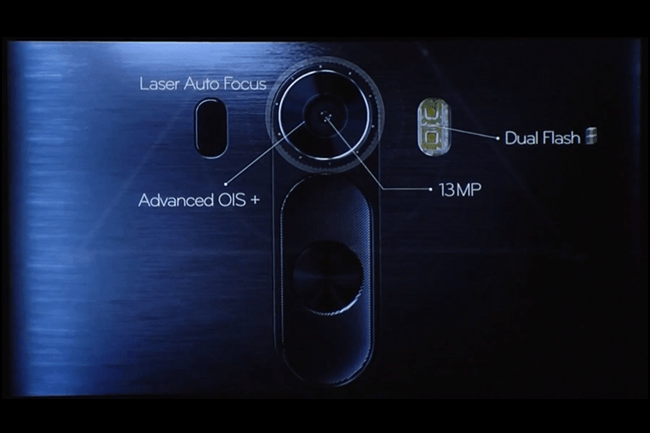
Check out our full written LG G3 review.
Today, on May 27, 2014, LG revealed its latest smartphone, the LG G3 “phablet.” The brand new device was unveiled in London, and LG is dead-set on offering customers a simple design with the best hardware around. One highlight of this gadget is a laser-powered autofocus system built right in with its 13-megapixel camera. Here’s what we know so far about the new camera.
Most smartphones (and digital cameras) on the market today use either phase detection, contrast detection, or a mixture of both (hybrid) in order to properly focus a subject. These methods utilize the camera’s autofocus points on the sensor in order to bring everything into focus. However, they can have disadvantages depending on your lighting conditions, making focusing harder to achieve. Even with proper lighting, many smartphone cameras have difficulty focusing. To work around this problem, LG has put a fast, accurate laser on the G3’s back that the camera uses to assist with focusing. LG had touted a fast AF system in the G2, which uses nine AF points in the sensor. With the G3, LG is looking to push autofocusing even further.
In concept, the AF technology isn’t new, and is very similar to what you’d find in a compact camera or radar gun that police officers use. Called an “active AF system,” it uses light to measure the distance between the camera and the subject or object, which the camera’s sensor then uses to correct focus (what we described above – phase detection, contract detection, and hybrid AF – are known as passive AF systems). As an example, when your standard digital camera is trying to focus in low-light situations, you may have noticed an orange light projected before the camera focuses and snaps the photos. This is an AF Assist beam, which uses infrared light to help the camera determine focus, when the flash isn’t used.
What’s new here, we think, is the use of an infrared laser that has a longer wavelength than the infrared light standalone digital cameras use. It bounces off whatever you’re trying to focus on, and the device picks up that reflection, but at a much faster rate (imagine about how quickly a laser pointer hits an object). With the help of some built-in software, the LG G3 is then able to focus the image based upon the focusing information that the laser provides. This is the first time we know of a smartphone getting a laser focus built right into the unit, or any consumer device for that matter. LG claims that only some of the more expensive DSLRs have such a focusing feature, although we aren’t aware of any that do (there are third-party accessories). (Nikon had been rumored to be working on such a system before abandoning it.)
We’re not sure yet just how capable or effective the technology is, but LG claims the G3’s focusing power is much faster than conventional focusing. In fact, it says the G3 takes just 276 milliseconds to focus an image. For comparison, it takes 300 milliseconds to blink an eye. In theory, this means the camera can focus on a moving object and capture it without losing focus. This technology is combined with a 13-megapixel camera and touch-to-shoot technology, allowing fast photography without waiting for your camera to focus. This takes away a lot of the hassle experienced with phablets, where focusing can be very difficulty as you try to both hold a huge phone and press to focus the camera. Modern police speed guns utilize laser instead of radar, which is faster and more accurate; it’s possible that the laser beam in the G3 works to deliver the same results, but, as we know, there are many other factors that contribute to a good photo.
According to LG, the G3 also includes enhanced optical image stabilization (OIS) technology with 30-percent better camera shake control technology when compared to its predecessor, the G2. LG’s Head of Mobile Product Marketing for Europe, James Marshall, even claims that the “LG G3 makes selfies simple,” calling it the “The Ultimate Selfie Camera.” The phone has a special mode allowing users to gesture to the G3 when they’re taking a photo, and the smartphone will count down for three seconds before taking the shot. LG also says video capture has been enhanced, thanks to the improved mic quality that automatically chooses the best setting for the ambient noise levels detected.
It’s interesting that LG has decided to use this system instead of the dual-camera method HTC employs, or the MEMS refocusing camera module that the LG-made Nexus 5 was rumored to include. Is it marketing nonsense? Many smartphones are notorious for slow autofocus, so it’s a feature we definitely want to put to the test. As mentioned, there are lots that go into a good photo, but a fast AF system and strong OIS will help. Let’s not forget about the sensor and software, as those also matter.
Check out our full coverage on the LG G3 to find out everything else you need to know about the new smartphone, such as the specs and its release date. We’ll also have a hands-on soon with the G3 and its Laser Auto Focus camera, to find out if it’s as good as LG claims.

